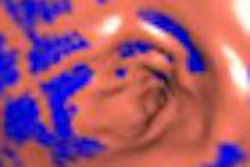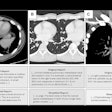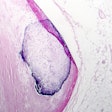Smoking is strongly associated with the presence of flat adenomas, and those who smoke are also likely to have larger flat adenomas, according to research from Stony Brook University Medical Center in Stony Brook, NY. The group says its results are the first to associate smoking with flat colorectal lesions.
Compared to high-resolution optical colonoscopy, virtual colonoscopy is considered to have lower sensitivity for small, flat lesions, some of which may also elude detection at conventional optical colonoscopy. Limited data on the natural history of polyps has led to ongoing debate about the clinical significance of flat lesions. In this study, however, the researchers found no cases of high-grade dysplasia or carcinoma among the flat lesions in their cohort.
Although screening colonoscopy has been shown to reduce the incidence of colorectal cancer, emerging data suggest that the magnitude of protection from the exam may be higher for the left versus the right side of the colon. In addressing this question, flat lesions "may play a role in explaining missed colorectal cancers on the right side of the colon," wrote Joseph Anderson, MD, and colleagues (Gastrointestinal Endoscopy, June 2010, Vol. 71:7, pp. 1234-1240).
Though the association between flat adenomas and smoking may be new, smoking has been shown to be an important risk factor for colorectal neoplasia in several screening and population-based studies. In addition, smokers may be at risk for increased frequency of mutations in the mismatch repair enzymes associated with microsatellite instability, Anderson and colleagues noted.
In addition, B-raf and K-ras mutations have been associated with smoking, as well as with nonpolypoid lesions and serrated lesions, which may leave smokers at higher risk for flat polyps, the authors noted.
"Little is known regarding the risk factors for these flat lesions, which may account for over one-half of all adenomas detected with a high-definition colonoscope," they wrote. "More information could help identify which patients would be suited to the use of new technologies such as high-definition colonoscopy."
The researchers aimed to examine the association between smoking and flat adenomas in 600 asymptomatic screening subjects (median age, 56 years; 252 men) using a high-definition wide-angle colonoscope (1080i signal, 170° field-of-view, 180 Series, Olympus America, Center Valley, PA).
Advanced neoplasia included large (≥ 1 cm) adenomas (including serrated adenomas), villous adenomas (≥ 25% villous), high-grade dysplasia, and cancer. Two experienced endoscopists confirmed the morphology using randomly selected adenomas from the photodocumentation. Polyp size was confirmed by the pathology report.
The researchers also recorded demographic data, known colorectal cancer risk factors, medication, family history of colorectal cancer, diet, exercise, alcohol intake, and history of diabetes and cholecystectomy.
Patients were asked about current or past cigarette use, the number of packs smoked per day, the number of years they had smoked, the year of cessation for those who had quit, and any changes in their past smoking patterns. The patients were divided into groups of nonsmokers, heavy smokers (10 or more pack years and still smoking or quit within the past 10 years), and low-exposure smokers (less than 10 pack years or those who quit more than 10 years earlier).
The study included 313 nonsmokers, 115 heavy smokers, and 172 low-exposure smokers. The median number of pack years in the heavy smoking group was 32 (interquartile range, 21-42). Most had smoked at least 20 pack years (79.1%; 91/115).
The results showed that smoking was associated with having a flat adenoma of any size (adjusted odds ratio [OR], 2.53; 95% confidence interval [CI]: 1.60-4.00). It was also associated with having only flat adenomas ≥ 6 mm in diameter (adjusted OR, 3.84; 95% CI: 2.02-7.32) and with having flat advanced adenomas (adjusted OR, 2.81; 95% CI: 1.08-7.30), the group reported.
Still, smoking wasn't the only risk factor at play. "Compared with the nonsmokers, the heavy smokers were more likely to describe themselves as white, regularly using [nonsteroidal anti-inflammatory drugs (NSAIDs)], eating more red meat, and consuming fewer fruits and tomato products," Anderson and colleagues noted.
There were 127 patients who had at least one flat adenoma of any size in the analyzed sample of 428 subjects (313 nonsmokers and 115 heavy-exposure smokers). After univariate analyses, heavy smoking, obesity, age 56 years or older, male gender, lack of exercise, and not using statins all had an association with any flat adenomas (p < 0.10). After multivariate analysis, heavy smoking, age, and male gender were all statistically associated with any flat adenomas of any size.
Also examined was the risk of having only flat adenomas 6 mm or larger. This group of 44 patients had no polypoid lesions. "Smoking, not taking statins regularly, and obesity (body mass index ≥ 30) were significantly associated with this outcome," Anderson and colleagues wrote.
|
||||||||||||
| Chart shows increased risk of flat adenomas ≥ 6 mm and of histologically advanced flat adenomas in heavy smokers versus nonsmokers. |
Most flat polyps were tubular adenomas, and although there was a statistically significant association between smoking and advanced flat adenomas, the numbers were small, the authors noted. Among them the researchers found two villous adenomas, but no cases of high-grade dysplasia or adenocarcinoma. Most of the serrated adenomas were also in smokers, in very small numbers.
Among the study's limitations, the colonoscopists were not blinded to the study hypothesis regarding the prevalence of flat lesions in smokers. In addition, the findings "may be applicable only to populations similar to our relatively young population, which had more women than men, they wrote.
"These demographics may explain our lower rate of advanced histopathology compared with a recent Veterans Affairs study by Soetikno et al," they wrote, adding that J Kim et al demonstrated a similarly low rate of advanced pathology.
"Although we did not observe an aggressive histology in our flat adenomas, these polyps, especially the larger adenomas, are important precursors to colorectal cancer," they wrote. "Their morphology may make them difficult to detect; therefore, identifying a risk factor that may increase a patient’s predilection for them is clinically important."
The findings could explain the observation that smokers often present with colorectal cancer at a younger age and at more advanced stages than nonsmokers, Anderson and colleagues wrote.
By Eric Barnes
AuntMinnie.com staff writer
July 1, 2010
Related Reading
Japanese group finds lower VC sensitivity for carpet lesions, May 26, 2010
CAD catches most flat polyps on virtual colonoscopy, December 16, 2009
ACRIN: Virtual colonoscopy sensitive for flat polyps, October 13, 2009
Flat-polyp measurements show less variability in 3D VC, September 16, 2009
VC's high positive predictive value important for colonoscopy follow-up, April 30, 2009
Copyright © 2010 AuntMinnie.com




















